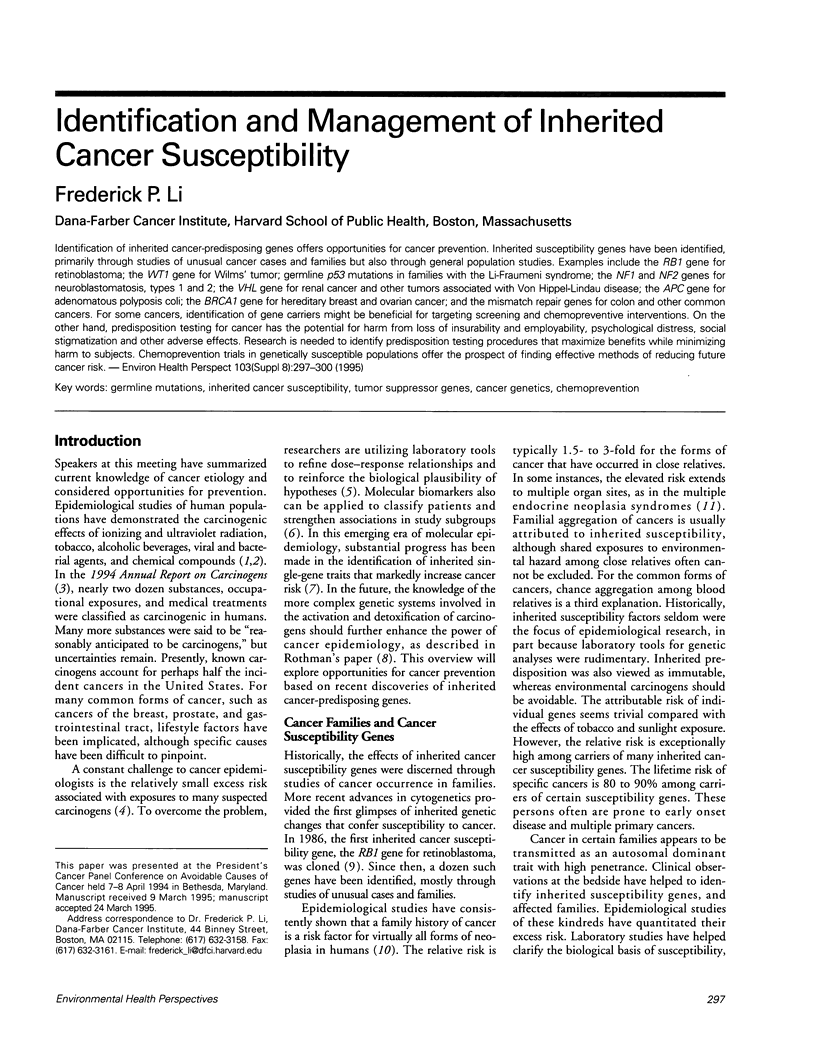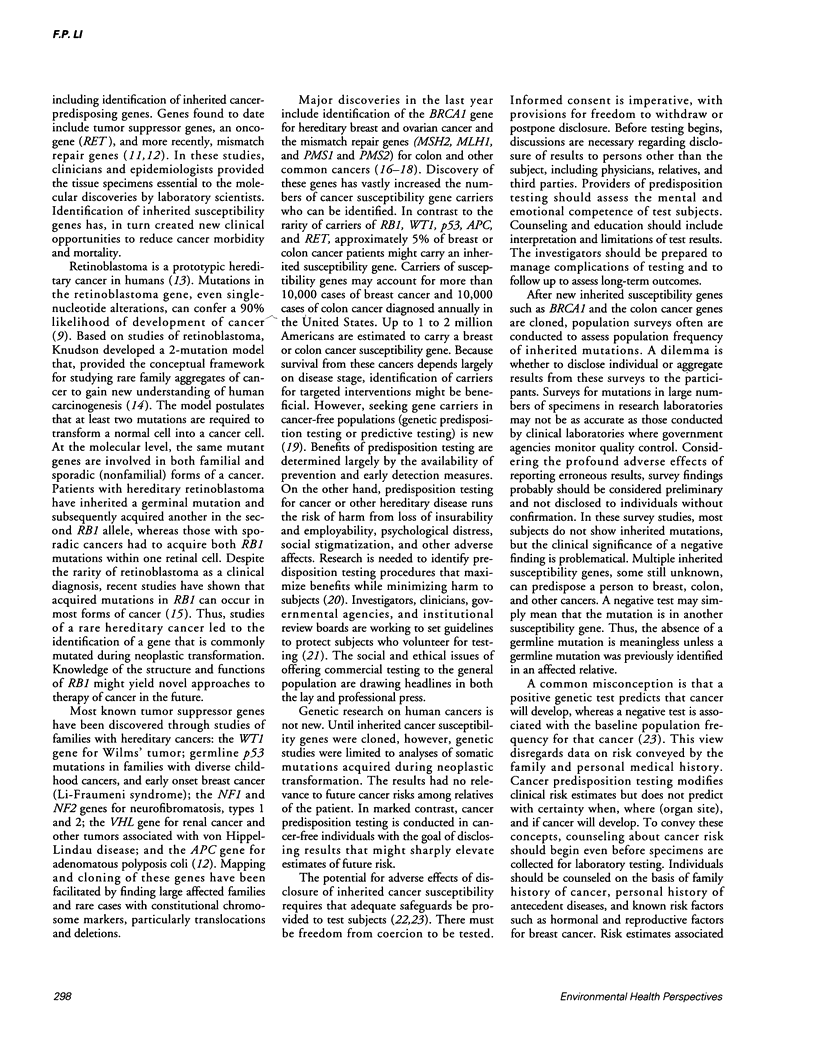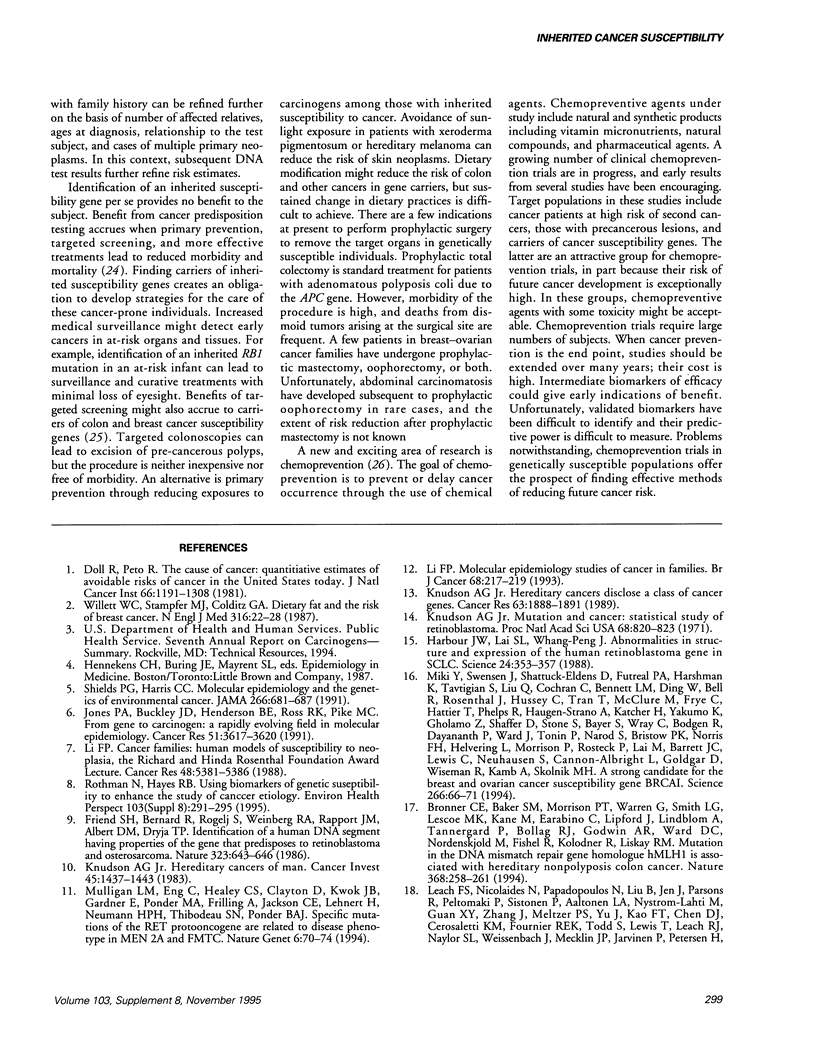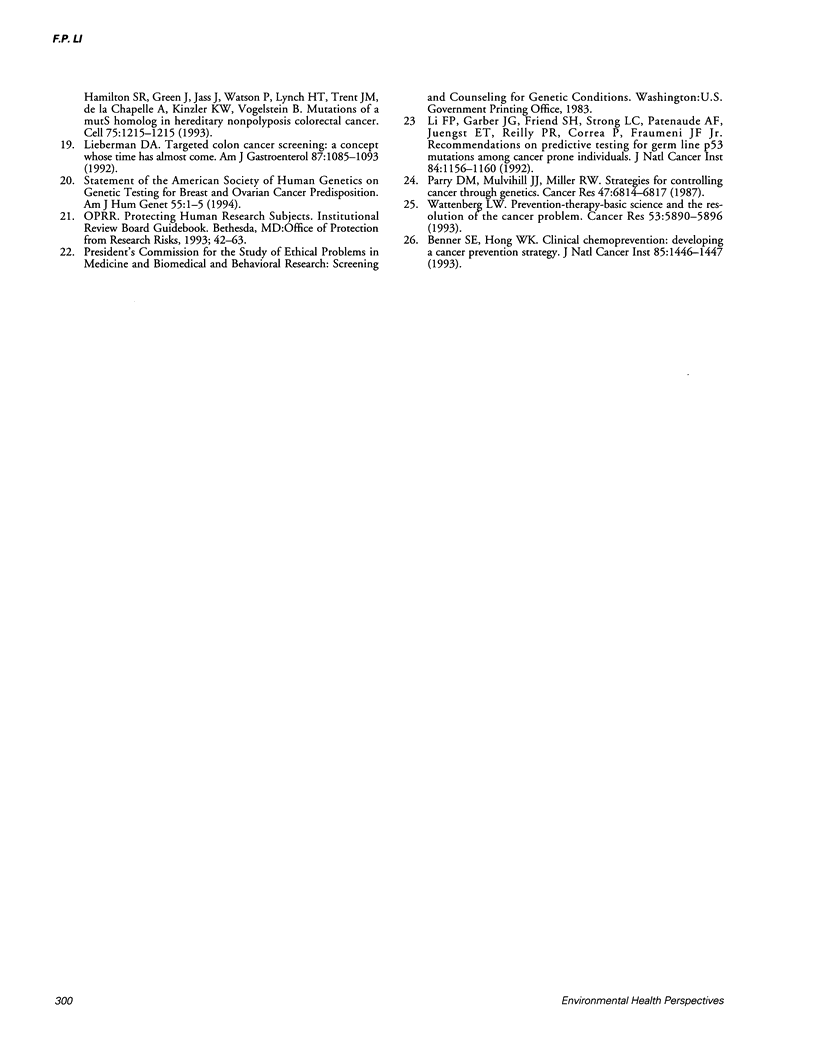Abstract
Identification of inherited cancer-predisposing genes offers opportunities for cancer prevention. Inherited susceptibility genes have been identified, primarily through studies of unusual cancer cases and families but also through general population studies. Examples include the RB1 gene for retinoblastoma; the WT1 gene for Wilms' tumor; germline p53 mutations in families with the Li-Fraumeni syndrome; the NF1 and NF2 genes for neuroblastomatosis, types 1 and 2; the VHL gene for renal cancer and other tumors associated with Von Hippel-Lindau disease; the APC gene for adenomatous polyposis coli; the BRCA1 gene for hereditary breast and ovarian cancer; and the mismatch repair genes for colon and other common cancers. For some cancers, identification of gene carriers might be beneficial for targeting screening and chemopreventive interventions. On the other hand, predisposition testing for cancer has the potential for harm from loss of insurability and employability, psychological distress, social stigmatization and other adverse effects. Research is needed to identify predisposition testing procedures that maximize benefits while minimizing harm to subjects. Chemoprevention trials in genetically susceptible populations offer the prospect of finding effective methods of reducing future cancer risk.
Full text
PDF



Selected References
These references are in PubMed. This may not be the complete list of references from this article.
- Benner S. E., Hong W. K. Clinical chemoprevention: developing a cancer prevention strategy. J Natl Cancer Inst. 1993 Sep 15;85(18):1446–1447. doi: 10.1093/jnci/85.18.1446. [DOI] [PubMed] [Google Scholar]
- Bronner C. E., Baker S. M., Morrison P. T., Warren G., Smith L. G., Lescoe M. K., Kane M., Earabino C., Lipford J., Lindblom A. Mutation in the DNA mismatch repair gene homologue hMLH1 is associated with hereditary non-polyposis colon cancer. Nature. 1994 Mar 17;368(6468):258–261. doi: 10.1038/368258a0. [DOI] [PubMed] [Google Scholar]
- Doll R., Peto R. The causes of cancer: quantitative estimates of avoidable risks of cancer in the United States today. J Natl Cancer Inst. 1981 Jun;66(6):1191–1308. [PubMed] [Google Scholar]
- Friend S. H., Bernards R., Rogelj S., Weinberg R. A., Rapaport J. M., Albert D. M., Dryja T. P. A human DNA segment with properties of the gene that predisposes to retinoblastoma and osteosarcoma. Nature. 1986 Oct 16;323(6089):643–646. doi: 10.1038/323643a0. [DOI] [PubMed] [Google Scholar]
- Harbour J. W., Lai S. L., Whang-Peng J., Gazdar A. F., Minna J. D., Kaye F. J. Abnormalities in structure and expression of the human retinoblastoma gene in SCLC. Science. 1988 Jul 15;241(4863):353–357. doi: 10.1126/science.2838909. [DOI] [PMC free article] [PubMed] [Google Scholar]
- Jones P. A., Buckley J. D., Henderson B. E., Ross R. K., Pike M. C. From gene to carcinogen: a rapidly evolving field in molecular epidemiology. Cancer Res. 1991 Jul 1;51(13):3617–3620. [PubMed] [Google Scholar]
- Knudson A. G., Jr Hereditary cancers disclose a class of cancer genes. Cancer. 1989 May 15;63(10):1888–1891. doi: 10.1002/1097-0142(19890515)63:10<1888::aid-cncr2820631004>3.0.co;2-l. [DOI] [PubMed] [Google Scholar]
- Knudson A. G., Jr Mutation and cancer: statistical study of retinoblastoma. Proc Natl Acad Sci U S A. 1971 Apr;68(4):820–823. doi: 10.1073/pnas.68.4.820. [DOI] [PMC free article] [PubMed] [Google Scholar]
- Li F. P. Cancer families: human models of susceptibility to neoplasia--the Richard and Hinda Rosenthal Foundation Award lecture. Cancer Res. 1988 Oct 1;48(19):5381–5386. [PubMed] [Google Scholar]
- Li F. P., Garber J. E., Friend S. H., Strong L. C., Patenaude A. F., Juengst E. T., Reilly P. R., Correa P., Fraumeni J. F., Jr Recommendations on predictive testing for germ line p53 mutations among cancer-prone individuals. J Natl Cancer Inst. 1992 Aug 5;84(15):1156–1160. doi: 10.1093/jnci/84.15.1156. [DOI] [PubMed] [Google Scholar]
- Li F. P. Molecular epidemiology studies of cancer in families. Br J Cancer. 1993 Aug;68(2):217–219. doi: 10.1038/bjc.1993.318. [DOI] [PMC free article] [PubMed] [Google Scholar]
- Lieberman D. A. Targeted colon cancer screening: a concept whose time has almost come. Am J Gastroenterol. 1992 Sep;87(9):1085–1093. [PubMed] [Google Scholar]
- Miki Y., Swensen J., Shattuck-Eidens D., Futreal P. A., Harshman K., Tavtigian S., Liu Q., Cochran C., Bennett L. M., Ding W. A strong candidate for the breast and ovarian cancer susceptibility gene BRCA1. Science. 1994 Oct 7;266(5182):66–71. doi: 10.1126/science.7545954. [DOI] [PubMed] [Google Scholar]
- Mulligan L. M., Eng C., Healey C. S., Clayton D., Kwok J. B., Gardner E., Ponder M. A., Frilling A., Jackson C. E., Lehnert H. Specific mutations of the RET proto-oncogene are related to disease phenotype in MEN 2A and FMTC. Nat Genet. 1994 Jan;6(1):70–74. doi: 10.1038/ng0194-70. [DOI] [PubMed] [Google Scholar]
- Parry D. M., Mulvihill J. J., Miller R. W., Berg K., Carter C. L. Strategies for controlling cancer through genetics. Cancer Res. 1987 Dec 15;47(24 Pt 1):6814–6817. [PubMed] [Google Scholar]
- Rothman N., Hayes R. B. Using biomarkers of genetic susceptibility to enhance the study of cancer etiology. Environ Health Perspect. 1995 Nov;103 (Suppl 8):291–295. doi: 10.1289/ehp.95103s8291. [DOI] [PMC free article] [PubMed] [Google Scholar]
- Shields P. G., Harris C. C. Molecular epidemiology and the genetics of environmental cancer. JAMA. 1991 Aug 7;266(5):681–687. [PubMed] [Google Scholar]
- Wattenberg L. W. Prevention--therapy--basic science and the resolution of the cancer problem. Cancer Res. 1993 Dec 15;53(24):5890–5896. [PubMed] [Google Scholar]
- Willett W. C., Stampfer M. J., Colditz G. A., Rosner B. A., Hennekens C. H., Speizer F. E. Dietary fat and the risk of breast cancer. N Engl J Med. 1987 Jan 1;316(1):22–28. doi: 10.1056/NEJM198701013160105. [DOI] [PubMed] [Google Scholar]


